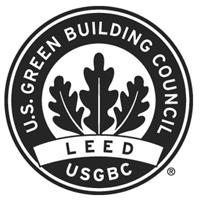LEED Certification and Drip Irrigation

Drip Irrigation can be a useful tool in achieving LEED certification. LEED, (Leadership in Energy and Environmental Design) as described in the U.S. Green Building Council website is a “rating system that encourages the adoption of sustainable green building and development practices through the implementation of universally understood and accepted tools based on performance levels.” Performance of a development is rated in 5 categories one of which is water efficiency. Irrigation on commercial sites can be a prime opportunity to save water used in landscaping. On its own, drip irrigation will not reduce a plant’s water requirement. In a given environment and soil condition, a plant will require the same amount of water, regardless of the irrigation method. When considering water conservation and plant health, there is no substitute for good management. Given this, when should drip irrigation be the system of choice? The answer to this question depends on the project and the system selection criteria. Although system cost-effectiveness is always an important consideration, LEED outlines how water and associated savings be taken into consideration. There are many other benefits that can be realized from the use of drip irrigation including: healthier plants; improved aesthetics; water and nutrient conservation; reduction of run-off and erosion potential; and reduction in the hazards of over spray. Water savings in drip irrigation stems from more efficient application of water. A drip system maximizes the water going to the plant root zone and minimizes the losses associated with evaporation, over spray and wind effects. This alone can represent a considerable advantage in operating costs. It is estimated that even the most basic drip emitter is at least 75% efficient right out of the box, to achieve the same level of efficiency with broadcast irrigation the system must be managed constantly. The choice of plant material is extremely important as well; many species are more resistant to specific geographical conditions. It is best to specify plant material that will have the best chance to thrive in the project area, such as native plants. The intent of the Water-efficient Landscaping credit in the LEED certification is to “limit or eliminate the use of potable water, or other natural surface or subsurface water resources available on or near the project site, for landscape irrigation.” The best way to achieve this goal is to select the best tool for the job, there are many drip irrigation products available in multiple different configurations utilize the options to maximize your systems water efficiency.



_.png)



















